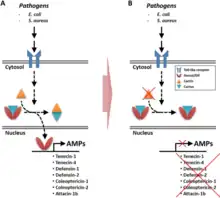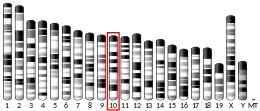CACTIN
Cactin also known as renal carcinoma antigen NY-REN-24 is a protein that in humans is encoded by the CACTIN gene.[5][6][7]

Cactin was originally identified in Drosophila (fruit flies). The cactin gene is product is involved in the regulation of the innate immune system. It acts as negative regulator of the toll-like receptor, Interferon regulatory factor (IRF) and the canonical NF-kappa-B signaling pathways.[9]
Structure
The full-length cactin protein length is 3,150 bp long and with an N-terminus from 356–547 residues and a domain in the C-terminal 731–855 residues.[10]
Species and tissue distributhion
This protein resides in many organs and tissues of all vertebrates, however, it has also been found in plants, protist, and fungi. The location that is highest in concentration of cactin gene is in the testis of males and in the spleen. The cactin gene in this specific area like the testis, enables RNA binding activity. This protein was also found to be involved in other process like cellular response from cytokines and negative signal transduction (negative feed back loops).[11]
In plants
In plants, the cactcin is associated with SR proteins localized in nuclear speckles.[12] Plant and human cells share the same spliceosomal proteins, which involved the removal of introns in order to form mature messenger RNA.
References
- GRCh38: Ensembl release 89: ENSG00000105298 - Ensembl, May 2017
- GRCm38: Ensembl release 89: ENSMUSG00000034889 - Ensembl, May 2017
- "Human PubMed Reference:". National Center for Biotechnology Information, U.S. National Library of Medicine.
- "Mouse PubMed Reference:". National Center for Biotechnology Information, U.S. National Library of Medicine.
- Andersson B, Wentland MA, Ricafrente JY, Liu W, Gibbs RA (April 1996). "A "double adaptor" method for improved shotgun library construction". Analytical Biochemistry. 236 (1): 107–113. doi:10.1006/abio.1996.0138. PMID 8619474.
- Yu W, Andersson B, Worley KC, Muzny DM, Ding Y, Liu W, et al. (April 1997). "Large-scale concatenation cDNA sequencing". Genome Research. 7 (4): 353–358. doi:10.1101/gr.7.4.353. PMC 139146. PMID 9110174.
- "Entrez Gene: C19orf29 chromosome 19 open reading frame 29".
- Jo YH, Kim YJ, Park KB, Seong JH, Kim SG, Park S, et al. (April 2017). "TmCactin plays an important role in Gram-negative and -positive bacterial infection by regulating expression of 7 AMP genes in Tenebrio molitor". Scientific Reports. 7 (1): 46459. Bibcode:2017NatSR...746459J. doi:10.1038/srep46459. PMC 5394457. PMID 28418029.
- "CACTIN Gene - GeneCards | CATIN Protein | CATIN Antibody". www.genecards.org. Retrieved 2022-03-03.
- Zhang S, Shi L, Yang QH, Dong XH, Chi SY, Liu HY, Tan BP (December 2014). "Molecular characterization and functional analysis of Cactin gene from Litopenaeus vannamei". Fish & Shellfish Immunology. 41 (2): 608–617. doi:10.1016/j.fsi.2014.10.014. PMID 25462455.
- "CACTIN cactin, spliceosome C complex subunit [Homo sapiens (human)] - Gene - NCBI". www.ncbi.nlm.nih.gov. Retrieved 2022-04-24.
- Baldwin KL, Dinh EM, Hart BM, Masson PH (April 2013). "CACTIN is an essential nuclear protein in Arabidopsis and may be associated with the eukaryotic spliceosome". FEBS Letters. 587 (7): 873–879. doi:10.1016/j.febslet.2013.02.041. PMID 23454656. S2CID 10857716.
Further reading
- Scanlan MJ, Gordan JD, Williamson B, Stockert E, Bander NH, Jongeneel V, et al. (November 1999). "Antigens recognized by autologous antibody in patients with renal-cell carcinoma". International Journal of Cancer. 83 (4): 456–464. doi:10.1002/(SICI)1097-0215(19991112)83:4<456::AID-IJC4>3.0.CO;2-5. PMID 10508479.
- Jurica MS, Licklider LJ, Gygi SR, Grigorieff N, Moore MJ (April 2002). "Purification and characterization of native spliceosomes suitable for three-dimensional structural analysis". RNA. 8 (4): 426–439. doi:10.1017/S1355838202021088. PMC 1370266. PMID 11991638.
- Lehner B, Semple JI, Brown SE, Counsell D, Campbell RD, Sanderson CM (January 2004). "Analysis of a high-throughput yeast two-hybrid system and its use to predict the function of intracellular proteins encoded within the human MHC class III region". Genomics. 83 (1): 153–167. doi:10.1016/S0888-7543(03)00235-0. PMID 14667819.
- Brandenberger R, Wei H, Zhang S, Lei S, Murage J, Fisk GJ, et al. (June 2004). "Transcriptome characterization elucidates signaling networks that control human ES cell growth and differentiation". Nature Biotechnology. 22 (6): 707–716. doi:10.1038/nbt971. PMID 15146197. S2CID 27764390.
- Beausoleil SA, Jedrychowski M, Schwartz D, Elias JE, Villén J, Li J, et al. (August 2004). "Large-scale characterization of HeLa cell nuclear phosphoproteins". Proceedings of the National Academy of Sciences of the United States of America. 101 (33): 12130–12135. Bibcode:2004PNAS..10112130B. doi:10.1073/pnas.0404720101. PMC 514446. PMID 15302935.



